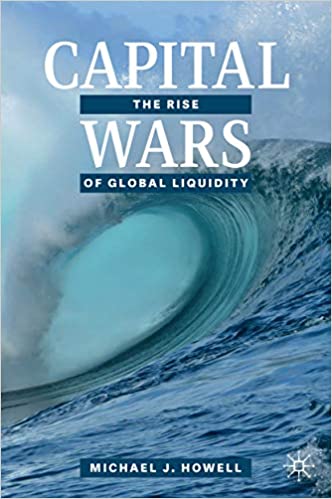Economic cycles are driven by financial flows, namely quantities of savings and credits, and not by high street inflation or interest rates. Their sweeping destructive powers are expressed through Global Liquidity, a $130 trillion pool of footloose cash. Global Liquidity describes the gross flows of credit and international capital feeding through the world’s banking systems and wholesale money markets. The huge jump in the volume of international financial markets since the mid-1980s has been boosted by deregulation, innovation and easy money, with financial globalisation now surpassing the peaks of integration reached before the First World War. Global Liquidity drives these markets: it is often determinant, frequently disruptive and always fast-moving. Barely one fifth of Wall Street’s huge gains over recent decades have come from earnings: rising liquidity and investors’ appetite for riskier financial assets have propelled stock prices higher. Similar experiences are shared worldwide and even in emerging markets, such as India, flat earnings have not deterred waves of foreign money and domestic mutual funds from driving-up stock prices. Now with central banks actively pursuing quantitative easing policies, industrial corporations flush with cash and rising wealth levels among emerging market investors, the liquidity theory of investment has never been more important.
International spill-overs of these rapacious cross-border flows sets off capital wars and exposes the unattractive face of liquidity called ‘risk.’ As the world grows bigger, it becomes ever more volatile. From the early 1960s onwards, the world economy and its financial markets have suffered from three broad types of shocks – labour costs, oil and commodities, and global liquidity. Financial markets spin on fragile axes and the absence of liquidity often provides a warning of upcoming troubles.
Global Liquidity is a much-discussed, but narrowly-researched and vaguely-defined topic. This book deeply explores the subject by clearly defining and measuring liquidity worldwide and by showing its importance for investors. The roles of central banks, shadow banking, the rise of Repo and growth of wholesale money are discussed. Additionally, covering the latest developments in China’s increasingly dominant financial economy, this book will appeal to practitioners, policy-makers, economists and academics, as well as those with a general interest in how financial markets work.
چکیده فارسی
چرخههای اقتصادی توسط جریانهای مالی، یعنی مقادیر پسانداز و اعتبار، هدایت میشوند و نه تورم خیابانی یا نرخهای بهره بالا. قدرت مخرب گسترده آنها از طریق نقدینگی جهانی، یک استخر 130 تریلیون دلاری پول نقد بیان می شود. نقدینگی جهانی جریان های ناخالص اعتبار و سرمایه بین المللی را که از طریق سیستم های بانکی جهان و بازارهای پول عمده فروشی تغذیه می شود، توصیف می کند. جهش عظیم در حجم بازارهای مالی بینالمللی از اواسط دهه 1980 توسط مقررات زدایی، نوآوری و پول آسان تقویت شده است و جهانیسازی مالی اکنون از قلههای یکپارچگی پیش از جنگ جهانی اول فراتر رفته است. نقدینگی جهانی این بازارها را هدایت می کند: اغلب تعیین کننده، اغلب مخرب و همیشه سریع حرکت می کند. تقریباً یک پنجم سودهای عظیم وال استریت در دهههای اخیر از درآمد حاصل شده است: افزایش نقدینگی و اشتهای سرمایهگذاران برای داراییهای مالی پرریسکتر، قیمت سهام را بالاتر برده است. تجارب مشابهی در سرتاسر جهان به اشتراک گذاشته شده است و حتی در بازارهای نوظهور مانند هند، درآمدهای ثابت موجی از پول خارجی و صندوق های سرمایه گذاری داخلی را از افزایش قیمت سهام منصرف نکرده است. اکنون با توجه به اینکه بانکهای مرکزی فعالانه سیاستهای تسهیل کمی را دنبال میکنند، شرکتهای صنعتی سرشار از پول نقد و افزایش سطح ثروت در میان سرمایهگذاران بازارهای نوظهور هستند، نظریه نقدینگی سرمایهگذاری هرگز مهمتر از این نبوده است.
سرریزهای بینالمللی این جریانهای فرامرزی درنده، جنگهای سرمایه را به راه میاندازد و چهره غیرجذاب نقدینگی به نام «ریسک» را آشکار میکند. با بزرگتر شدن جهان، بیثباتتر میشود. از اوایل دهه 1960 به بعد، اقتصاد جهانی و بازارهای مالی آن از سه نوع شوک بزرگ رنج برده اند - هزینه های نیروی کار، نفت و کالاها و نقدینگی جهانی. بازارهای مالی بر روی محورهای شکننده می چرخند و فقدان نقدینگی اغلب هشداری درباره مشکلات آتی است.
نقدینگی جهانی موضوعی است که بسیار مورد بحث و بررسی قرار گرفته، اما به طور محدود و به طور مبهم تعریف شده است. این کتاب با تعریف واضح و اندازه گیری نقدینگی در سراسر جهان و با نشان دادن اهمیت آن برای سرمایه گذاران، موضوع را عمیقاً بررسی می کند. نقش بانکهای مرکزی، بانکداری سایه، ظهور رپو و رشد پول عمدهفروشی مورد بحث قرار میگیرد. علاوه بر این، این کتاب با پوشش آخرین تحولات در اقتصاد مالی چین که به طور فزایندهای مسلط است، برای پزشکان، سیاستگذاران، اقتصاددانان و دانشگاهیان و همچنین کسانی که علاقه کلی به نحوه عملکرد بازارهای مالی دارند، جذاب خواهد بود.
ادامه ...
بستن ...
Ebook details:
عنوان: Capital Wars: The Rise of Global Liquidity
نویسنده: Howell, Michael J.
ناشر: Palgrave Macmillan; 1st ed. 2020 edition (March 25, 2020)
زبان: English
شابک: 3030392872, 978-3030392871
حجم: 5 Mb
فرمت: Original PDF
ادامه ...
بستن ...










